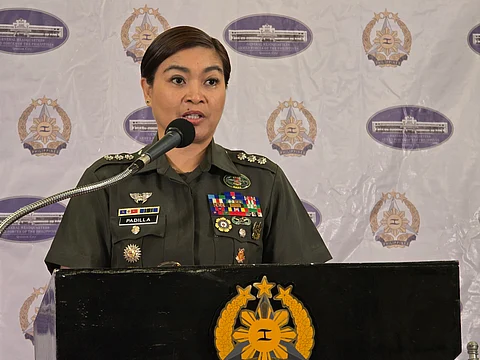
- NEWS
- the EDIT
- COMMENTARY
- BUSINESS
- LIFE
- SHOW
- ACTION
- GLOBAL GOALS
- SNAPS
- DYARYO TIRADA
- MORE

The Armed Forces of the Philippines (AFP) on Tuesday said all nine Enhanced Defense Cooperation Agreement (EDCA) sites in the country are activated as part of the country’s disaster response efforts amid ongoing inclement weather.
In a press briefing at Camp Aguinaldo, AFP spokesperson Col. Francel Margareth Padilla said these EDCA sites will serve as primary hubs for prepositioning of military assets as well as command and control centers to be used for the military's enhanced ground operations, including search, rescue, and relief missions during calamities.
“This is not the first time that the EDCA sites were used during calamities,” Padilla said, noting that the EDCA sites are operating as “multirole facilities.”
“So, for this, at this point in time, whatever EDCA site is nearest in the most afflicted areas [during calamities], we will be using them. So they can be used as command and control hubs, they can be used as repacking areas for relief goods or any other purpose that it may be deemed necessary to use these EDCA sites,” she added.
The existing EDCA sites include Cesar Basa Air Base in Floridablanca, Pampanga; Fort Magsaysay Military Reservation in Nueva Ecija; Lumbia Airport in Cagayan De Oro; Antonio Bautista Air Base in Puerto Princesa, Palawan; and Benito Ebuen Air Base in Cebu; as well as the Naval Base Camilo Osias in Sta. Ana, Cagayan; Lal-lo Airport in Lal-lo, Cagayan; Camp Melchor Dela Cruz in Gamu, Isabela; and Balabac Island in Palawan.
Previously, Defense Secretary Gilberto Teodoro Jr. said these EDCA sites were strategically built in the country’s most disaster-prone areas.
Aside from essential uses of EDCA sites for the country’s credible deterrent posture and territorial integrity, Teodoro stressed it is also necessary in operations that demand humanitarian assistance and disaster relief requirements.
Leveraging allies
In a statement on Tuesday, AFP chief Gen. Romeo Brawner Jr. said the activation of the EDCA sites highlights how the country’s defense partnerships, particularly with the United States, are helping the Filipino troops on the ground.
Brawner said the AFP is in close coordination with the US Indo-Pacific Command to ensure seamless interoperability from utilizing “these shared facilities, transport, and airlift assets” in humanitarian missions.
“Using these forward-operating hubs allows us to deliver aid faster and more efficiently to our fellow Filipinos, especially in hard-hit and remote areas,” he said.
“This kind of rapid response can spell the difference between life and death.”
Brawner said the AFP “is leveraging every available advantage,” including its strong alliances and strategic infrastructure, to fulfill its most sacred mandate of serving and protecting our people.
“The use of EDCA sites is not just a logistical decision but a commitment to bring support and comfort to our kababayans with all possible speed and efficiency,” he added.
